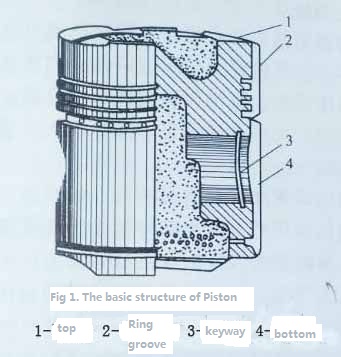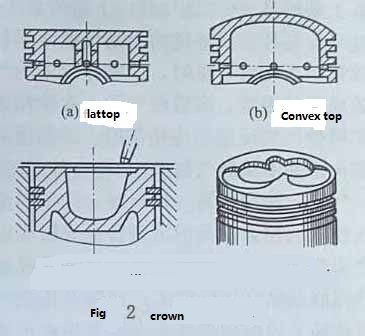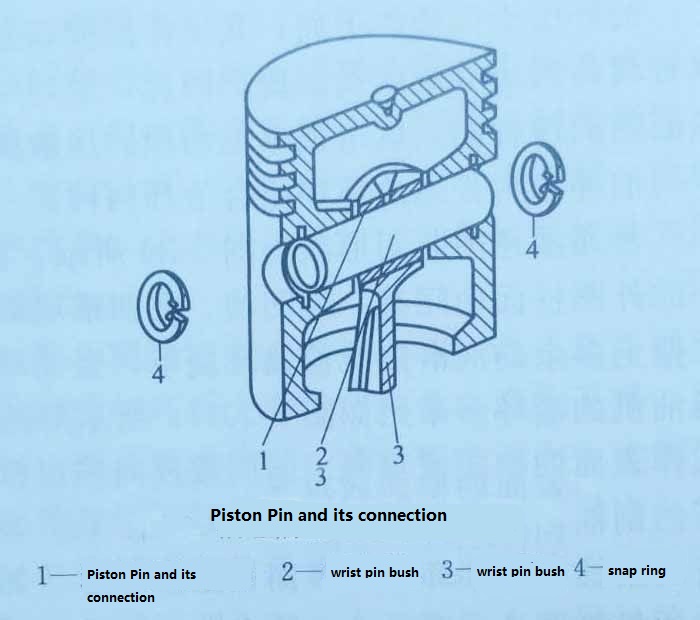The diesel generator piston set consists of a piston, a piston ring and a piston pin. The piston is the pressure of the gas and transmits the force to the crankshaft via the connecting rod. The working condition of the piston is very bad. It is continuously moving at high speed and reciprocating linear motion under the action of high temperature and high pressure gas. Due to the reciprocating inertial force of the periodically changing gas pressure, the piston is subjected to large mechanical and thermal loads, and uneven temperature distribution causes thermal stress. Therefore, the piston must not be too heavy and have sufficient strength and rigidity.
High-speed diesel engines usually use cast aluminum alloys. As diesel engines continue to strengthen, pistons using wrought aluminum alloys or eutectic aluminum-silicon alloys are increasing, while high-boost diesel engines use cast iron pistons in order to increase the strength of the diesel engine and reduce the coefficient of thermal expansion. The basic structure of the piston is shown in Figure 1. It can be divided into four parts: the top, the ring groove, the piston pin seat and the skirt.

The top part is part of the combustion chamber and the shape of the structure is related to the form of the diesel engine and the combustion chamber. Figure 2 shows several different structural shapes of the top of the piston. The structure of Fig. 2(a) is mostly used for small diesel engines. Most diesel engines use the two forms of Figure 2(c)(d).

The thermal load on the piston is large, especially for direct injection diesel engines, which cause thermal fatigue and cracks in the piston. Therefore, some diesel engines can spray oil from the injection holes on the small end of the connecting rod to cool the inner wall of the piston top. Some diesel engines have a special fuel injection mechanism in the body to play the same role. The top of the piston is generally thick due to the pressure of the gas; some have a rib inside the top of the piston.
The ring groove is mainly used to install the piston ring to prevent fuel or gas from leaking into the crankcase, and the heat absorbed by the piston is transmitted to the cylinder wall through the piston ring, and the lubricating oil is sucked into the combustion chamber. The piston head is machined with a number of ring grooves for mounting the piston ring, the top 2-3 for the air ring, and the lower 1-2 for the oil ring groove. The oil ring groove is drilled with a plurality of radial holes so that the oil ring scrapes excess oil from the cylinder wall and flows back from the orifice to the crankcase.
The pin seat is used to mount the piston pin and acts to transmit air pressure. There is often a rib between the piston pin seat and the top to increase stiffness. A ring groove is formed in the pin hole for mounting the elastic snap ring. The piston pin ring is used to prevent the piston pin from axially swaying during operation, and the piston pin hole is broken to break the cylinder block.
The portion of the piston head below the lowest oil ring groove is called the skirt. The function is to guide the movement of the piston in the cylinder, and it also bears the side pressure. Due to the high gas pressure and large side pressure, the diesel engine is also long to reduce the pressure and wear per unit area.
The function of the piston pin of the diesel generator set is to connect the piston and the connecting rod, and to withstand the reciprocating inertial force and gas pressure when the piston moves, and transmit it to the connecting rod. The middle of the piston pin passes through the small hole of the connecting rod, and both ends are supported in the hole of the piston pin seat as shown in the figure 3.

The piston pin is subjected to a large periodic impact load at high temperatures. The relative sliding speed of the outer surface of the piston pin and the small end bushing of the connecting rod is not high, and the general lubrication condition is poor, and the splashing lubrication is mostly. Therefore, the piston pin is required to have sufficient strength and rigidity. In order to reduce the reciprocating inertia force, the weight of the piston pin is light. Piston pins are usually made of high quality steel or alloy steel. The outer surface is subjected to carburizing or cyanidation and then finely ground to achieve high surface finish and precision. In order to improve the fatigue resistance, the inner and outer surface of the piston pin can be simultaneously carburized and quenched.
The piston pin is generally made of a hollow cylinder and is fully floating. Full floating means that the piston pin can rotate freely in the small end of the connecting rod and the piston pin seat when the diesel engine is working. This simple structure, the slow rotation of the piston pin facilitates the distribution of the splashed lubricating oil on the friction surface, so that the wear is reduced, and the wear along the length of the piston pin and the circumference can be relatively uniform. In order to prevent the piston pin from axially pulling and pulling the cylinder wall, the piston pin is equipped with a piston pin retaining ring at both ends, and the snap ring should be inserted into the groove of the piston pin seat hole.
Since the expansion coefficient of the aluminum piston is large, in order to ensure proper clearance between the piston pin and the pin seat hole during operation, there is a certain interference between them at normal temperature. For ease of installation and damage to the mating surface, the piston is usually heated to 70-90 ° C in water or oil, and the piston pin is pushed into the seat hole.
Copyright © Guangxi Dingbo Generator Set Manufacturing Co., Ltd. All Rights Reserved | Sitemap
Update cookies preferences